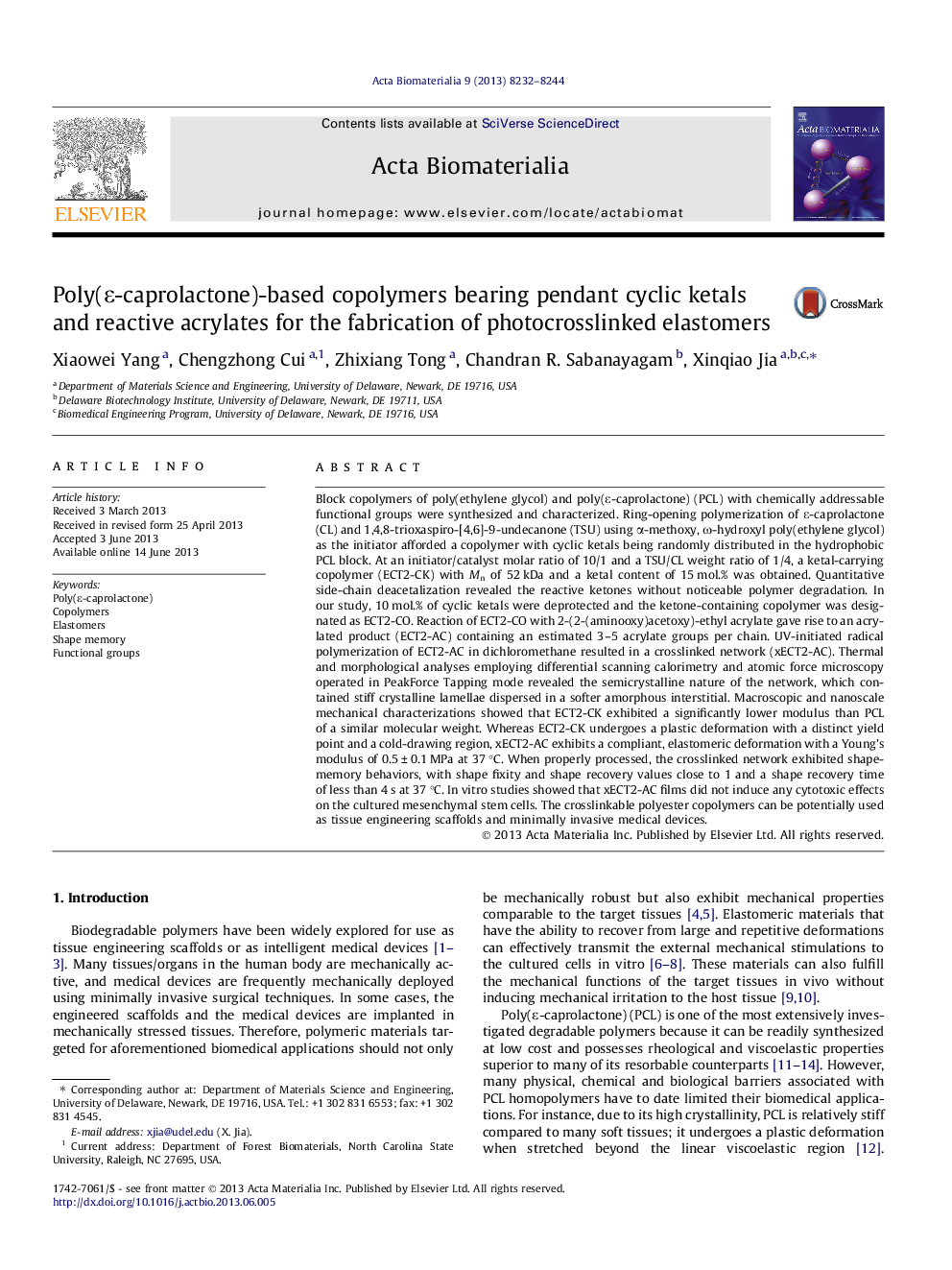| کد مقاله | کد نشریه | سال انتشار | مقاله انگلیسی | نسخه تمام متن |
|---|---|---|---|---|
| 10159789 | 58 | 2013 | 13 صفحه PDF | دانلود رایگان |
عنوان انگلیسی مقاله ISI
Poly(ε-caprolactone)-based copolymers bearing pendant cyclic ketals and reactive acrylates for the fabrication of photocrosslinked elastomers
دانلود مقاله + سفارش ترجمه
دانلود مقاله ISI انگلیسی
رایگان برای ایرانیان
کلمات کلیدی
موضوعات مرتبط
مهندسی و علوم پایه
مهندسی شیمی
بیو مهندسی (مهندسی زیستی)
پیش نمایش صفحه اول مقاله

چکیده انگلیسی
Block copolymers of poly(ethylene glycol) and poly(ε-caprolactone) (PCL) with chemically addressable functional groups were synthesized and characterized. Ring-opening polymerization of ε-caprolactone (CL) and 1,4,8-trioxaspiro-[4,6]-9-undecanone (TSU) using α-methoxy, Ï-hydroxyl poly(ethylene glycol) as the initiator afforded a copolymer with cyclic ketals being randomly distributed in the hydrophobic PCL block. At an initiator/catalyst molar ratio of 10/1 and a TSU/CL weight ratio of 1/4, a ketal-carrying copolymer (ECT2-CK) with Mn of 52 kDa and a ketal content of 15 mol.% was obtained. Quantitative side-chain deacetalization revealed the reactive ketones without noticeable polymer degradation. In our study, 10 mol.% of cyclic ketals were deprotected and the ketone-containing copolymer was designated as ECT2-CO. Reaction of ECT2-CO with 2-(2-(aminooxy)acetoxy)-ethyl acrylate gave rise to an acrylated product (ECT2-AC) containing an estimated 3-5 acrylate groups per chain. UV-initiated radical polymerization of ECT2-AC in dichloromethane resulted in a crosslinked network (xECT2-AC). Thermal and morphological analyses employing differential scanning calorimetry and atomic force microscopy operated in PeakForce Tapping mode revealed the semicrystalline nature of the network, which contained stiff crystalline lamellae dispersed in a softer amorphous interstitial. Macroscopic and nanoscale mechanical characterizations showed that ECT2-CK exhibited a significantly lower modulus than PCL of a similar molecular weight. Whereas ECT2-CK undergoes a plastic deformation with a distinct yield point and a cold-drawing region, xECT2-AC exhibits a compliant, elastomeric deformation with a Young's modulus of 0.5 ± 0.1 MPa at 37 °C. When properly processed, the crosslinked network exhibited shape-memory behaviors, with shape fixity and shape recovery values close to 1 and a shape recovery time of less than 4 s at 37 °C. In vitro studies showed that xECT2-AC films did not induce any cytotoxic effects on the cultured mesenchymal stem cells. The crosslinkable polyester copolymers can be potentially used as tissue engineering scaffolds and minimally invasive medical devices.
ناشر
Database: Elsevier - ScienceDirect (ساینس دایرکت)
Journal: Acta Biomaterialia - Volume 9, Issue 9, September 2013, Pages 8232-8244
Journal: Acta Biomaterialia - Volume 9, Issue 9, September 2013, Pages 8232-8244
نویسندگان
Xiaowei Yang, Chengzhong Cui, Zhixiang Tong, Chandran R. Sabanayagam, Xinqiao Jia,